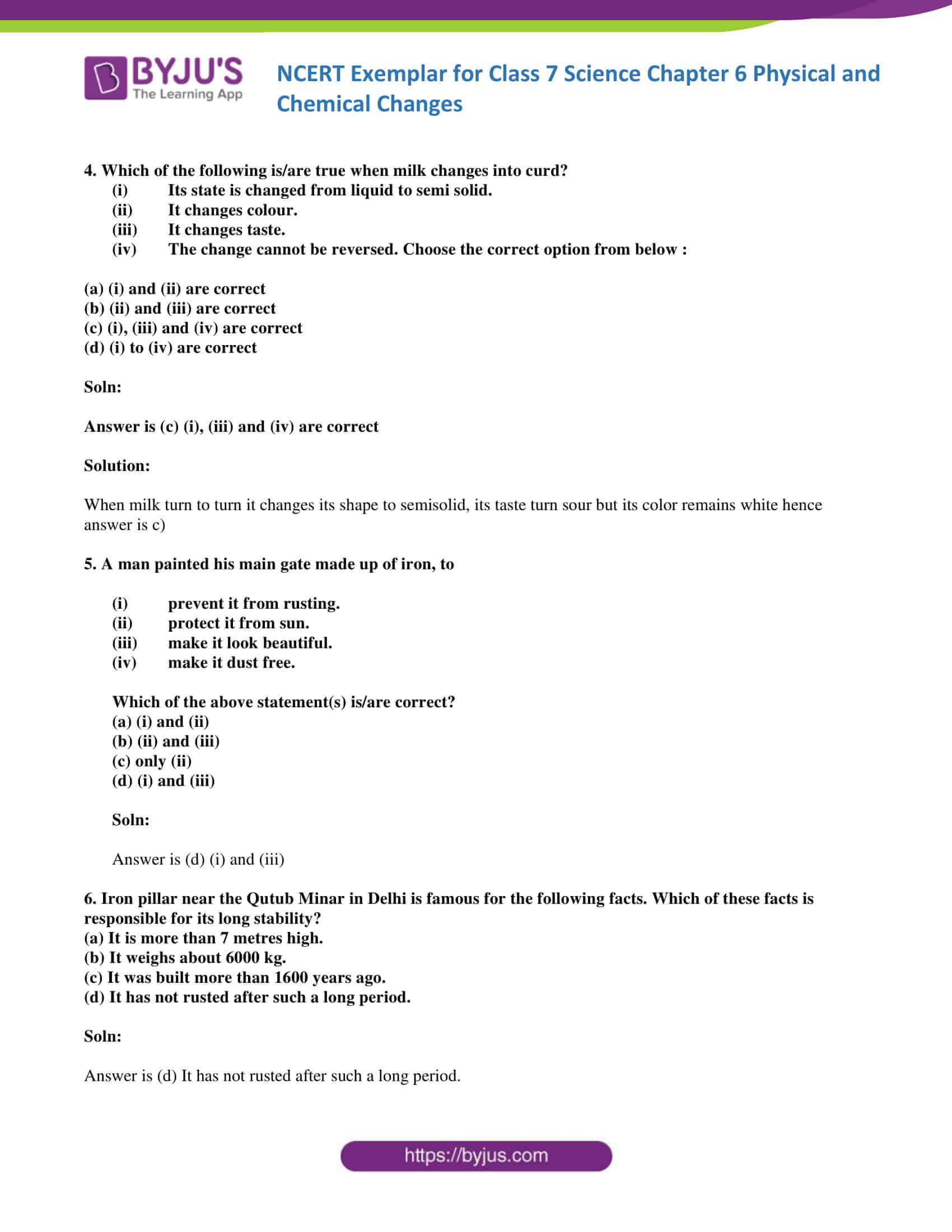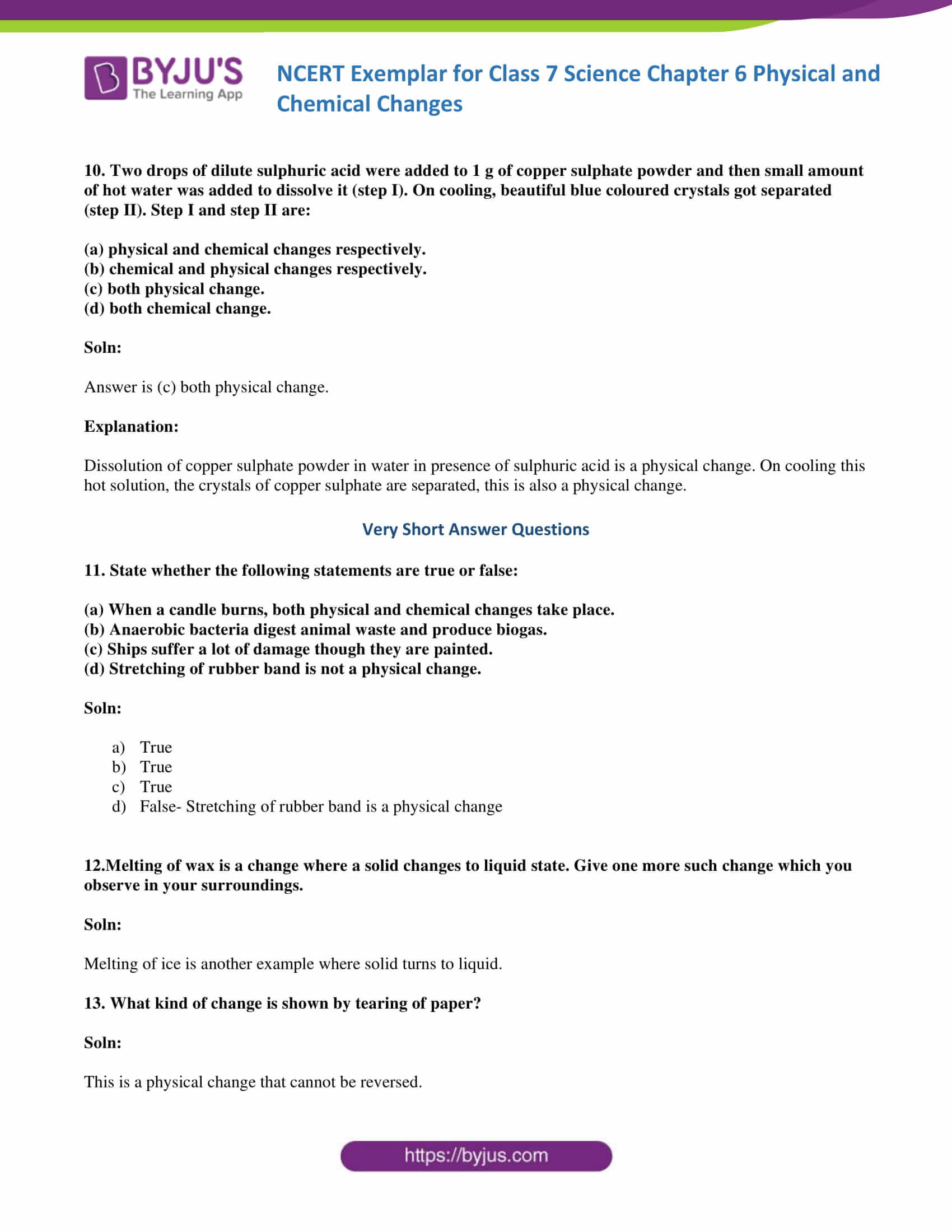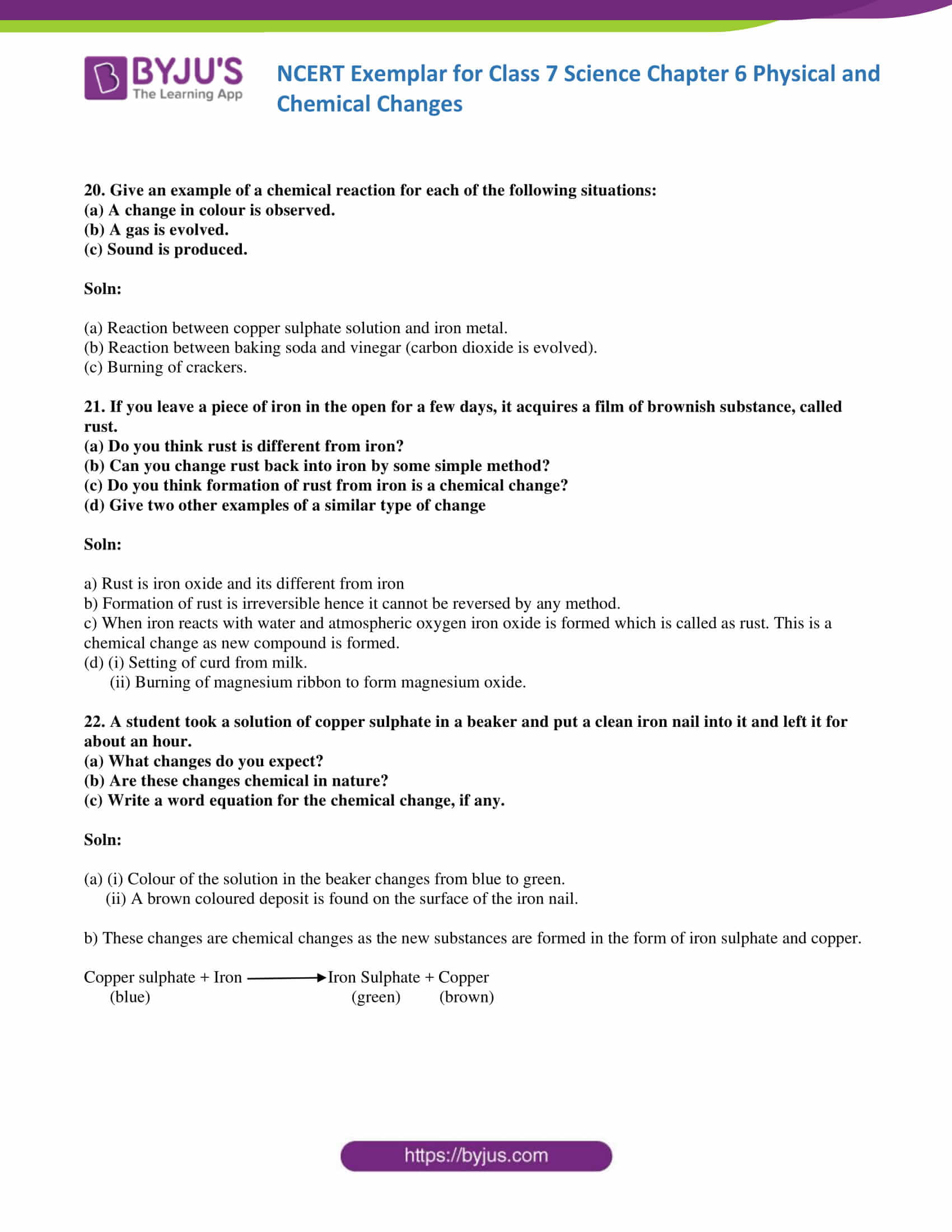NCERT Exemplar Solutions for Class 7 Science are the best study materials for students to prepare well and ace the final exam. These exemplar problems consist of different questions that help you study the topics covered in the NCERT textbook from a different perspective, thereby guiding you to attain perfection.
These NCERT exemplar solutions for Class 7 Science Chapter 6 Physical and Chemical Changes have answers and explanations to 10 multiple choice questions, answers to 3 very short answer questions, answers to 5 short answer questions and 4 long answer questions.
Download the PDF of the NCERT Exemplar for Class 7 Science Chapter 6 – Physical and Chemical Changes
The Importance of NCERT Exemplar for Class 7 Science Chapter 6 Physical and Chemical Changes
This NCERT Exemplar solution covers questions on changes in the nature of the objects, the process of rusting, burning magnesium ribbon and copper sulphate reactions. Here, you can also find answers to practical questions that involve chemical changes around us.
Topics Covered in the NCERT Exemplar for Class 7 Science Chapter 6 Physical and Chemical Changes
6.1 – Physical Changes
6.2 – Chemical Change
6.3 – Rusting of Iron
6.4 – Crystallisation
Access Answers of the NCERT Exemplar for Class 7 Science Chapter 6 – Physical and Chemical Changes
Multiple Choice Questions
1. Which of the following is a physical change?
(a) Rusting of iron
(b) Combustion of magnesium ribbon
(c) Burning of candle
(d) Melting of wax
Soln:
The answer is (d) Melting of wax
Explanation:
Rusting of iron, combustion and burning of the candle are chemical changes where produced cannot be converted into reactants.
2. Which of the following is a chemical change?
(a) Twinkling of stars
(b) Cooking of vegetables
(c) Cutting of fruits
(d) Boiling of water
Soln:
The answer is (b) Cooking of vegetables
3. A chemical change may involve –
(a) change in colour only
(b) change in temperature only
(c) evolution of gas only
(d) any or all of the above
Soln:
The answer is (d) any or all of the above
Explanation:
A chemical change may involve a change in colour, temperature, smell or evolution of gas, heat, etc.
4. Which of the following is/are true when milk changes into curd?
- Its state is changed from liquid to semi-solid.
- It changes colour.
- It changes the taste.
- The change cannot be reversed. Choose the correct option from below :
(a) (i) and (ii) are correct
(b) (ii) and (iii) are correct
(c) (i), (iii) and (iv) are correct
(d) (i) to (iv) are correct
Soln:
Answer is (c) (i), (iii) and (iv) are correct
Solution:
When milk turn to turn it changes its shape to semisolid, its taste turn sour but its colour remains white hence the answer is c)
5. A man painted his main gate made up of iron, to
- prevent it from rusting.
- protect it from the sun.
- make it look beautiful.
- make it dust-free.
Which of the above statement(s) is/are correct?
(a) (i) and (ii)
(b) (ii) and (iii)
(c) only (ii)
(d) (i) and (iii)
Soln:
The answer is (d) (i) and (iii)
6. Iron pillar near the Qutub Minar in Delhi is famous for the following facts. Which of these facts is responsible for its long stability?
(a) It is more than 7 metres high.
(b) It weighs about 6000 kg.
(c) It was built more than 1600 years ago.
(d) It has not rusted after such a long period.
Soln:
The answer is (d) It has not rusted after such a long period.
7. Galvanisation is a process used to prevent the rusting of which of the following?
(a) Iron
(b) Zinc
(c) Aluminium
(d) Copper
Soln:
The answer is (a) Iron
Explanation:
During Galvanisation iron is coated with Zinc to prevent rusting.
8. Paheli’s mother made a concentrated sugar syrup by dissolving sugar in hot water. On cooling, crystals of sugar got separated. This indicates a –
(a) a physical change that can be reversed.
(b) the chemical change that can be reversed.
(c) a physical change that cannot be reversed.
(d) the chemical change that cannot be reversed.
Soln:
The answer is (a) physical change that can be reversed.
Explanation:
Here sugar can be separated from a supersaturated solution hence it is a reversible change.
9. Which of the following statement is incorrect for a chemical reaction?
(a) Heat may be given out but never absorbed.
(b) The sound may be produced.
(c) A colour change may take place.
(d) A gas may be evolved.
Soln:
The answer is (a) Heat may be given out but never absorbed.
Explanation:
During chemical reaction heat may be absorbed or given out hence option a) is a wrong statement.
10. Two drops of dilute sulphuric acid were added to 1 g of copper sulphate powder and a then a small amount of hot water was added to dissolve it (step I). On cooling, beautiful blue coloured crystals got separated (step II). Step I and Step II are:
(a) physical and chemical changes, respectively.
(b) chemical and physical changes, respectively.
(c) both physical change.
(d) both chemical change.
Soln:
The answer is (c) both physical change.
Explanation:
Dissolution of copper sulphate powder in water in the presence of sulphuric acid is a physical change. On cooling this hot solution, the crystals of copper sulphate are separated, this is also a physical change.
Very Short Answer Questions
11. State whether the following statements are true or false:
(a) When a candle burns, both physical and chemical changes take place.
(b) Anaerobic bacteria digest animal waste and produce biogas.
(c) Ships suffer a lot of damage though they are painted.
(d) Stretching of the rubber band is not a physical change.
Soln:
- True
- True
- True
- False- Stretching of the rubber band is a physical change
12. Melting of wax is a change where a solid changes to a liquid state. Give one more such change which you observe in your surroundings.
Soln:
Melting of ice is another example where solid turns to liquid.
13. What kind of change is shown by tearing of paper?
Soln:
This is a physical change that cannot be reversed.
Short Answer Questions
14. Match the items of Column I with the items of Column II.
| Column I | Column II |
| a) Large Crystals | (i)Turns lime water milky |
| b) Depositing a layer of Zinc on Iron | (ii) Physical change |
| c) Souring of milk | (iii) Rust |
| d) Carbon-di-oxide | (iv) Sugar candy (Mishri) |
| e) Iron oxide | (v) Chemical change |
| f) Dissolving common salt in water | (vi) Galvanization. |
Soln:
| Column I | Column II |
| a) Large Crystals | (iv) Sugar candy (Mishri) |
| b) Depositing a layer of Zinc on Iron | (vi) Galvanization. |
| c) Souring of milk | (v) Chemical change |
| d) Carbon-di-oxide | (i)Turns lime water milky |
| e) Iron oxide | (iii) Rust |
| f) Dissolving common salt in water | (ii) Physical change |
15. Fill in the blanks in the following statements using the words given in the box.

(a) Making sugar solution is a ____________ change.
(b) A physical change is generally____________.
(c) Grinding of wheat grain changes its size. It is a ____________ change.
(d) Iron benches kept in lawns and gardens get____________. It is a _________ change because a new _________ is formed.
Soln:
(a) Making sugar solution is a Physical change.
(b) A physical change is generally reversible.
(c) Grinding of wheat grain changes its size. It is a physical change.
(d) Iron benches kept in lawns and gardens get rusted. It is a chemical change because a new substance is formed.
16. Classify the following processes into physical or chemical changes:
(i) The beating of aluminium metal to make aluminium foil.
(ii) Digestion of food.
(iii) Cutting of a log of wood into pieces.
(iv) Burning of crackers.
Soln:
i) Physical change
ii) Chemical change
iii) Physical change
iv) Chemical change
17. Write word equations for two chemical reactions with the help of materials given in the box.

Soln:
(1) Iron + Air + Water _ Iron oxide
(2) Copper sulphate + Iron _ Iron sulphate + Copper
18. Explain the following:
(a) Lime water turns milky on passing carbon dioxide gas into it.
(b) Bubbles are produced when acetic acid is added to a solution of sodium hydrogen carbonate.
Soln:
(a) White coloured insoluble calcium carbonate is formed.
(b) Carbon dioxide is evolved due to the chemical reaction between acetic acid and sodium hydrogen carbonate.
Long Answer Questions
19. Give two examples for each of the following cases:
(a) Physical changes are reversible.
(b) Physical changes are not reversible.
(c) Chemical changes.
Soln:
- Folding of paper, melting of ice
- Tearing of paper, breaking of glass
- Curdling of milk, cooking of food
20. Give an example of a chemical reaction for each of the following situations:
(a) A change in colour is observed.
(b) Gas is evolved.
(c) Sound is produced.
Soln:
(a) The reaction between copper sulphate solution and iron metal.
(b) The reaction between baking soda and vinegar (carbon dioxide is evolved).
(c) Burning of crackers.
21. If you leave a piece of iron in the open for a few days, it acquires a film of brownish substance, called rust.
(a) Do you think rust is different from iron?
(b) Can you change rust back into iron by some simple method?
(c) Do you think the formation of rust from iron is a chemical change?
(d) Give two other examples of a similar type of change
Soln:
a) Rust is iron oxide and it’s different from iron
b) Formation of rust is irreversible hence it cannot be reversed by any method.
c) When iron reacts with water and atmospheric oxygen iron oxide is formed which is called rust. This is a chemical change as a new compound is formed.
(d) (i) The setting of curd from milk.
(ii) Burning of magnesium ribbon to form magnesium oxide.
22. A student took a solution of copper sulphate in a beaker and put a clean iron nail into it and left it for about an hour.
(a) What changes do you expect?
(b) Are these changes chemical in nature?
(c) Write a word equation for the chemical change, if any.
Soln:
(a) (i) Colour of the solution in the beaker changes from blue to green.
(ii) A brown coloured deposit is found on the surface of the iron nail.
b) These changes are chemical changes as the new substances are formed in the form of iron sulphate and copper.

BYJU’S provides NCERT Solutions, NCERT Exemplars, CBSE Sample Papers, solved previous years’ question papers and notes prepared by our subject experts. To get free access to all study materials provided by us, visit BYJU’S website or download BYJU’S – The Learning App.
Frequently Asked Questions on NCERT Exemplar for Class 7 Science Chapter 6 Physical and Chemical Changes
Melting of wax is a change where a solid changes to a liquid state. Give one more such change which you observe in your surroundings.
Melting of ice is another example where solid turns to liquid.
What kind of change is shown by the tearing of paper?
This is a physical change that cannot be reversed.







Comments